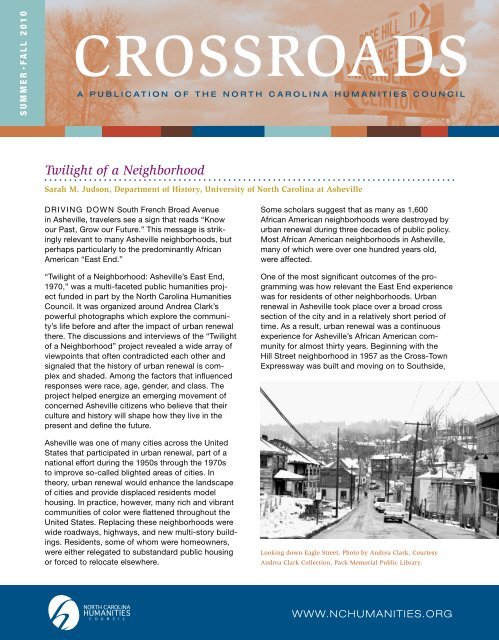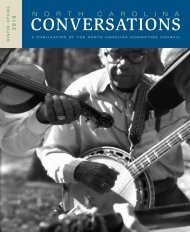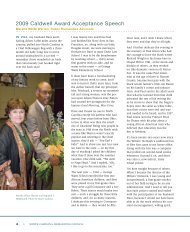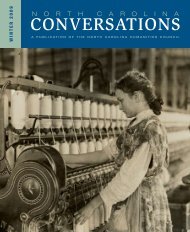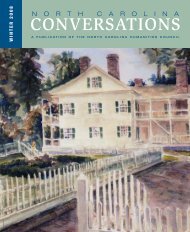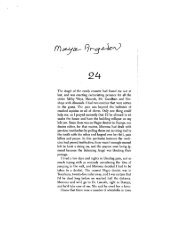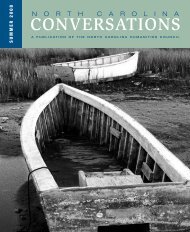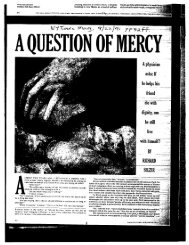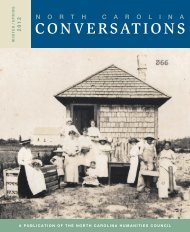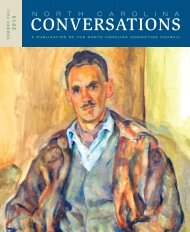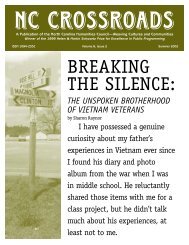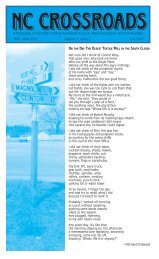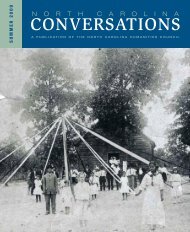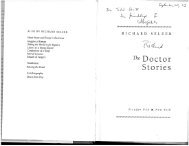Twilight of a Neighborhood - North Carolina Humanities Council
Twilight of a Neighborhood - North Carolina Humanities Council
Twilight of a Neighborhood - North Carolina Humanities Council
Create successful ePaper yourself
Turn your PDF publications into a flip-book with our unique Google optimized e-Paper software.
SUmmer • Fall 2010<br />
CROSSROADS<br />
A PublicAtion <strong>of</strong> the north cArolinA humAnities council<br />
<strong>Twilight</strong> <strong>of</strong> a <strong>Neighborhood</strong><br />
Sarah M. Judson, Department <strong>of</strong> History, University <strong>of</strong> <strong>North</strong> <strong>Carolina</strong> at Asheville<br />
Driving DOwn South French Broad Avenue<br />
in Asheville, travelers see a sign that reads “Know<br />
our Past, grow our Future.” This message is strikingly<br />
relevant to many Asheville neighborhoods, but<br />
perhaps particularly to the predominantly African<br />
American “East End.”<br />
“<strong>Twilight</strong> <strong>of</strong> a neighborhood: Asheville’s East End,<br />
1970,” was a multi-faceted public humanities project<br />
funded in part by the north <strong>Carolina</strong> <strong>Humanities</strong><br />
<strong>Council</strong>. it was organized around Andrea Clark’s<br />
powerful photographs which explore the community’s<br />
life before and after the impact <strong>of</strong> urban renewal<br />
there. The discussions and interviews <strong>of</strong> the “<strong>Twilight</strong><br />
<strong>of</strong> a neighborhood” project revealed a wide array <strong>of</strong><br />
viewpoints that <strong>of</strong>ten contradicted each other and<br />
signaled that the history <strong>of</strong> urban renewal is complex<br />
and shaded. Among the factors that influenced<br />
responses were race, age, gender, and class. The<br />
project helped energize an emerging movement <strong>of</strong><br />
concerned Asheville citizens who believe that their<br />
culture and history will shape how they live in the<br />
present and define the future.<br />
Asheville was one <strong>of</strong> many cities across the United<br />
States that participated in urban renewal, part <strong>of</strong> a<br />
national effort during the 1950s through the 1970s<br />
to improve so-called blighted areas <strong>of</strong> cities. in<br />
theory, urban renewal would enhance the landscape<br />
<strong>of</strong> cities and provide displaced residents model<br />
housing. in practice, however, many rich and vibrant<br />
communities <strong>of</strong> color were flattened throughout the<br />
United States. replacing these neighborhoods were<br />
wide roadways, highways, and new multi-story buildings.<br />
residents, some <strong>of</strong> whom were homeowners,<br />
were either relegated to substandard public housing<br />
or forced to relocate elsewhere.<br />
Some scholars suggest that as many as 1,600<br />
African American neighborhoods were destroyed by<br />
urban renewal during three decades <strong>of</strong> public policy.<br />
Most African American neighborhoods in Asheville,<br />
many <strong>of</strong> which were over one hundred years old,<br />
were affected.<br />
One <strong>of</strong> the most significant outcomes <strong>of</strong> the programming<br />
was how relevant the East End experience<br />
was for residents <strong>of</strong> other neighborhoods. Urban<br />
renewal in Asheville took place over a broad cross<br />
section <strong>of</strong> the city and in a relatively short period <strong>of</strong><br />
time. As a result, urban renewal was a continuous<br />
experience for Asheville’s African American community<br />
for almost thirty years. Beginning with the<br />
Hill Street neighborhood in 1957 as the Cross-Town<br />
Expressway was built and moving on to Southside,<br />
Looking down Eagle Street. Photo by Andrea Clark. Courtesy<br />
Andrea Clark Collection, Pack Memorial Public Library.<br />
www.nchumanities.org
Stumptown, Burton Street, and East End, the fabric<br />
<strong>of</strong> each <strong>of</strong> these historic African American communities<br />
was torn apart.<br />
Dr. Mindy Fullilove, pr<strong>of</strong>essor <strong>of</strong> clinical psychiatry<br />
and public health at Columbia University, defines this<br />
process as “root shock” in her groundbreaking Root<br />
Shock: How Tearing Up City <strong>Neighborhood</strong>s Hurts<br />
America and What We Can Do About It. root shock,<br />
according to Fullilove, is “the traumatic stress reaction<br />
to the loss <strong>of</strong> some or all <strong>of</strong> one’s emotional ecosystem.”<br />
This devastation <strong>of</strong> social networks, Fulliove<br />
explains, “is a pr<strong>of</strong>ound…upheaval that destroys the<br />
working model <strong>of</strong> the world that had existed in the<br />
individual’s head”; it results in a rupturing <strong>of</strong> individual<br />
and communal identity.<br />
As people looked at Clark’s photographs and<br />
attended programs, they voiced their experiences<br />
as a pr<strong>of</strong>ound sense <strong>of</strong> loss; they had a keen<br />
Vol. 14, Issue 1,<br />
s ummer/Fall 2010<br />
Guest Editor: Karen Loughmiller<br />
Managing Editor and Publisher:<br />
Harlan Joel Gradin, Associate<br />
Director <strong>of</strong> Programs/Director <strong>of</strong><br />
Community Development, <strong>North</strong><br />
<strong>Carolina</strong> <strong>Humanities</strong> <strong>Council</strong><br />
<strong>North</strong> <strong>Carolina</strong> <strong>Humanities</strong><br />
<strong>Council</strong> Staff:<br />
Shelley J. Crisp<br />
Lynn Wright-Kernodle<br />
Genevieve Cole<br />
Darrell Stover<br />
Jennifer McCollum<br />
Donovan McKnight<br />
Carolyn Allen<br />
Anne Tubaugh<br />
Tim Wolfe<br />
Design:<br />
Kilpatrick Design<br />
www.kilpatrickdesign.com<br />
Founding Publication<br />
Team <strong>of</strong> Crossroads:<br />
Katherine Kubel<br />
Pat Arnow<br />
Mary Lee Kerr<br />
Lisa Yarger<br />
Harlan Joel Gradin<br />
IssN 1094-2351 ©2010<br />
addItIoNal resources<br />
Brunk, Robert S., ed., May We All Remember<br />
Well: A Journal <strong>of</strong> the History & Culture <strong>of</strong><br />
Western NC. Vol. 2. Asheville: Robert S.<br />
Brunk Auction Services, Inc., 1983.<br />
Fullilove, Mindy Thompson. Root Shock: How<br />
Tearing Up City <strong>Neighborhood</strong>s Hurts<br />
America and What We Can Do About It.<br />
New York: One World/Ballantyne, 2005.<br />
Hanchett, Thomas W. Sorting Out the New South<br />
City: Race, Class, and Urban Development<br />
in Charlotte, 1875–1975. Chapel Hill:<br />
University <strong>of</strong> <strong>North</strong> <strong>Carolina</strong> Press, 1998.<br />
Mosley-Edington, Helen. Angels Unaware:<br />
Asheville’s Women <strong>of</strong> Color. Asheville:<br />
Home Press, 1996.<br />
—.Visionaries: Asheville’s Women <strong>of</strong> Color.<br />
Asheville: Home Press, 2000.<br />
Neufeld, Rob, and Henry Neufeld. Asheville’s<br />
River Arts District (Images <strong>of</strong> America: <strong>North</strong><br />
<strong>Carolina</strong>). Charleston: Arcadia Publishing,<br />
2008.<br />
oNlINe collectIoNs aNd exhIbIts<br />
The Andrea Clark Photographic Collection. <strong>North</strong><br />
<strong>Carolina</strong> Collection, Pack Library, Buncombe<br />
County Public Libraries, Asheville, NC. www.<br />
buncombecounty.org/governing/depts/library/<br />
Gallery/andreaClark/default.htm.<br />
Asheville Housing Authority Records and<br />
Heritage <strong>of</strong> Black Highlanders Collection.<br />
D.H. Ramsey Library Special Collections,<br />
University <strong>of</strong> <strong>North</strong> <strong>Carolina</strong> at Asheville.<br />
http://toto.lib.unca.edu/findingaids/mss/blackhigh/default_blackhigh.html.<br />
An Unmarked Trail: Stories <strong>of</strong> African Americans<br />
in Buncombe County from 1850–1950.<br />
understanding <strong>of</strong> what the cost <strong>of</strong> urban progress<br />
meant for them.<br />
Southside resident robert Hardy poetically describes<br />
his own experience: “But the Land!…The community<br />
breakdown: family displacement and the loss <strong>of</strong> businesses,<br />
neighbors, continuity, sanguinity, customs,<br />
cultures, and social norms.” One tangible symbol <strong>of</strong><br />
this process was the change <strong>of</strong> the name <strong>of</strong> valley<br />
Street to South Charlotte Street after a relative <strong>of</strong> one<br />
<strong>of</strong> Asheville’s largest slave owners, Charlotte Patton.<br />
“<strong>Twilight</strong> <strong>of</strong> a neighborhood” alerted all <strong>of</strong> Asheville<br />
to the personal stories <strong>of</strong> how people experienced<br />
the past. Andrea Clark’s photographs capture the<br />
full spectrum <strong>of</strong> community life in Asheville’s East<br />
End in 1970. The images portray a neighborhood<br />
with bustling business and street life, gardens where<br />
people grew their own food, and sidewalks on which<br />
children played under the watchful eyes <strong>of</strong> elders.<br />
Digital Exhibit. Center for Diversity<br />
Education, University <strong>of</strong> <strong>North</strong> <strong>Carolina</strong><br />
at Asheville, 2008. www.diversityed.org/<br />
unmarked-trail.<br />
With All Deliberate Speed: School Desegregation<br />
in Buncombe County. Digital Exhibit. Center<br />
for Diversity Education, University <strong>of</strong> <strong>North</strong><br />
<strong>Carolina</strong> at Asheville. www.diversityed.org/<br />
deliberate-speed.<br />
specIal thaNks<br />
This expanded edition <strong>of</strong> Crossroads has been<br />
made possible by contributions to the <strong>North</strong><br />
<strong>Carolina</strong> <strong>Humanities</strong> <strong>Council</strong> from the following<br />
donors:<br />
• SF James and Diane M. Abbott<br />
• Rob Amberg and Leslie Stilwell<br />
• DeWayne Barton<br />
• Kenneth Betsalel and Heidi Kelley<br />
• Andrea Clark<br />
• Harlan Joel Gradin<br />
• Johnnie Robinson Grant<br />
• Harry Harrison<br />
• Buck Hinman<br />
• Holly Jones<br />
• Millie Jones<br />
• Karen Loughmiller<br />
• Mountain Housing Opportunities<br />
• Dwight and Dolly Mullen<br />
• Betsy Murray<br />
• Priscilla Ndiaye<br />
• Marc Rudow and Deborah Miles<br />
• James Samsel and Kim McGuire<br />
• Will Scarbrough<br />
• Ed Sheary<br />
• Stephens-Lee Alumni Association, Inc.<br />
• Jonathan Tambellini<br />
• UNC Asheville Center for Diversity Education<br />
• UNC Asheville Intercultural Center<br />
• Alexandra J. Vrtunski<br />
•<br />
Cindy Visnich Weeks
This neighborhood was home to Stephens-Lee High<br />
School, the only African American public high school<br />
in western north <strong>Carolina</strong>. To those who lived there,<br />
East End was not a blighted or slum area, though at<br />
the same time poor housing conditions characterized<br />
many <strong>of</strong> the structures. Housing codes were not<br />
enforced and city <strong>of</strong>ficials failed to address damage<br />
from storms and sewage.<br />
Beginning on page eight, there are maps that<br />
visually locate the African American neighborhoods<br />
<strong>of</strong> Asheville discussed in this issue <strong>of</strong> Crossroads.<br />
They were rendered by Betsy Murray, an archivist<br />
at Pack Memorial Public Library, and include the<br />
East End, Southside, Stumptown and Hill Street,<br />
and Burton Street.<br />
Today, the dispossession <strong>of</strong> neighborhoods continues<br />
to resonate with most <strong>of</strong> those who were displaced.<br />
Many residents interviewed for the “<strong>Twilight</strong>”<br />
project discussed the painful severing <strong>of</strong> neighborhood<br />
ties and the disorientation that arises from<br />
not really knowing that a place is yours.<br />
However, it is not accurate to say that all residents,<br />
including African Americans, responded with acute<br />
pain. One project interviewee observed, “[i]t’s easy<br />
to get misty-eyed about…all the great collegiality and<br />
social networks…in these poor neighborhoods but a<br />
lot <strong>of</strong> people that lived [there]…were happy to get out<br />
<strong>of</strong> them…the point is it was mixed.”<br />
For some, urban renewal promised to rebuild cities<br />
and create positive changes in areas that looked as<br />
if they needed help. That there could be different<br />
understandings <strong>of</strong> the outcome <strong>of</strong> urban renewal<br />
illustrates how multi-dimensional this process really<br />
was. One <strong>of</strong> the key city administrators <strong>of</strong> urban<br />
renewal during the 1970s was David Jones, executive<br />
director <strong>of</strong> the Asheville Housing Authority (AHA).<br />
in 2008 he told Urban News that his job was “removing<br />
all substandard housing conditions to make a<br />
more livable environment for people who cannot do<br />
for themselves.” He continued, “People say the next<br />
thing they knew was that they looked up and they<br />
saw the bulldozers, but that’s not true. All <strong>of</strong> these<br />
urban renewal projects were pretty complicated.”<br />
in the same vein, Ken Michalove, Asheville’s city<br />
manager in the 1970s, recalls that “the urban renewal<br />
projects, the Opportunity Corporation, and the Model<br />
Cities Program helped make Asheville a livable community<br />
and helped make us...a top city in the United<br />
States to live in.” The issue is perhaps not what policies<br />
were implemented, but the ways in which they<br />
were implemented.<br />
Elijah Morgan at the entrance to the Savoy Hotel, 35 S. Market<br />
Street. Photo by Andrea Clark. Courtesy Andrea Clark Collection,<br />
Pack Memorial Public Library.<br />
Ed Sheary, director <strong>of</strong> the Buncombe County Public<br />
Library, places in sharp relief the power <strong>of</strong> Clark’s<br />
photographs to force personal reassessment <strong>of</strong> this<br />
period. He writes, “i am a fifty-four-year-old white<br />
male Asheville native, who well remembers the East<br />
End and watched it being demolished in the name<br />
<strong>of</strong> ‘urban renewal.’ i did not question the wisdom<br />
<strong>of</strong> tearing down and replacing substandard housing<br />
[until viewing]…Andrea Clark’s photographs….[Then]<br />
i saw the loss <strong>of</strong> neighborhood and all the human<br />
connections that entails.”<br />
right now, many residents from all over Asheville<br />
want to reclaim this history. There are efforts directed<br />
at renaming South Charlotte Street, creating a walking<br />
tour <strong>of</strong> the East End, and working to affect decisions<br />
about another road set to divide Burton Street.<br />
while the consequences <strong>of</strong> urban renewal may be<br />
difficult to dismantle, a renewed interest in this subject<br />
is sparking citizen engagement in determining<br />
the future.<br />
CROSSROADS • Summer/Fall 2010 • 3
About “<strong>Twilight</strong> <strong>of</strong> a <strong>Neighborhood</strong>: Asheville’s East End, 1970”<br />
Harlan Joel Gradin<br />
in 2008, Buncombe County Public Libraries and<br />
partners, the Center for Diversity Education, and the<br />
Stephens-Lee Alumni Association, received planning,<br />
mini-, and large grants from the north <strong>Carolina</strong><br />
<strong>Humanities</strong> <strong>Council</strong> for the project “<strong>Twilight</strong> <strong>of</strong> a<br />
neighborhood: Asheville’s East End, 1970,” which<br />
was fueled by the passion and vision <strong>of</strong> photographer<br />
Andrea Clark and project director Karen Loughmiller.<br />
Project team members included photographer rob<br />
Amberg, Stephens-Lee High School alumna Pat<br />
griffin, Sarah M. Judson <strong>of</strong> the University <strong>of</strong> north<br />
<strong>Carolina</strong> Asheville, public historian and director <strong>of</strong> UnC<br />
Asheville’s Center for Diversity Education Deborah<br />
Miles, archivist Betsy Murray, community historian<br />
Henry robinson, and Buncombe County Public Library<br />
Director Ed Sheary. The project utilized Clark’s extraordinary<br />
photographs from 1970 to examine in depth<br />
the history and consequences <strong>of</strong> urban renewal. while<br />
the initial geographic focus was East End, the project<br />
grew beyond those parameters as participants<br />
shared stories about urban renewal disruptions across<br />
Asheville’s African American communities. A culminating<br />
weekend <strong>of</strong> related events was hosted by a large<br />
group <strong>of</strong> community partners including UnC Asheville,<br />
the YMi Cultural Center, the Urban News, A-B Technical<br />
Community College, among others.<br />
The East End had been a vibrant black community since<br />
the 1880s, although African American presence there<br />
dates back to the earliest times <strong>of</strong> slavery in western<br />
north <strong>Carolina</strong>. The neighborhood flourished through<br />
the first half <strong>of</strong> the twentieth century, perhaps even as<br />
the practices <strong>of</strong> urban renewal began in the city in the<br />
1950s. By 1978, urban renewal had razed much <strong>of</strong> this<br />
once strong family <strong>of</strong> neighbors.<br />
Fortunately, Andrea Clark had taken intimate portraits<br />
<strong>of</strong> local life in 1970, before the neighborhood disappeared.<br />
Few knew <strong>of</strong> this collection <strong>of</strong> photographs,<br />
until “<strong>Twilight</strong> <strong>of</strong> a neighborhood.” Project activities<br />
included an exhibit, expansion <strong>of</strong> recent research and<br />
gathering <strong>of</strong> oral histories, story-sharing sessions,<br />
book discussions, and public forums, as well as related<br />
programs including a class at UnC Asheville and the<br />
current examination <strong>of</strong> revitalization in Asheville.<br />
Today, there is serious discussion <strong>of</strong> urban revitalization<br />
in Asheville that likely will include many more<br />
voices than in the mid-1970s. One important result <strong>of</strong><br />
“<strong>Twilight</strong>,” Loughmiller observes, is the ongoing partnership<br />
that emerged from participants’ “struggles…<br />
[in] learning to work together.” She continues, “Projects<br />
4 • NORtH CAROLiNA HuMANitiES COuNCiL<br />
Josie McCullough in the doorway <strong>of</strong> her home overlooking the busy<br />
intersection <strong>of</strong> Valley and Eagle Streets. Photo by Andrea Clark.<br />
Courtesy Andrea Clark Collection, Pack Memorial Public Library.<br />
that allow collaborative experiences to happen can<br />
empower people in a very real way and give momentum<br />
to the effort to reclaim control <strong>of</strong> our lives and our<br />
communities. in today’s world, what could be more<br />
important?”<br />
A core notion <strong>of</strong> “<strong>Twilight</strong> <strong>of</strong> a neighborhood” is “root<br />
shock,” a term developed by urban scholar and psychiatrist<br />
Mindy Fullilove, the keynote speaker at the project’s<br />
conclusion in February 2009. in a recent note to project<br />
participants, Fulillove quoted the European urban visionary<br />
Michel Cantal-Dupart, who wrote that “the cities <strong>of</strong><br />
the future are cities that have a past and they must lean<br />
on that past to find the way to break barriers and to<br />
create the means <strong>of</strong> sustaining our children one hundred<br />
years from now.” The exciting, organic, and intentional<br />
group <strong>of</strong> citizens who now have practice voicing their<br />
history in the most public way are reclaiming their past<br />
to define their future; they plan to sustain their children<br />
one hundred years from now.
Andrea Clark, Photographer: The Family <strong>of</strong> Man/These Were My Roots<br />
Karen Loughmiller, West Asheville Branch Library<br />
AnDrEA CLArK’S East End photographs are<br />
stunning. They hold your attention. You look at one,<br />
walk away, come back to look again. And again.<br />
“what was she thinking about?” you wonder. in an<br />
interview with documentary photographer and friend<br />
rob Amberg, Clark mused, “i was really thinking<br />
about the family <strong>of</strong> man...about that photograph that<br />
transcends you.” Yes. You see it.<br />
But wonderful as the images are, Andrea Clark<br />
herself ensured that the questions they evoke in our<br />
minds were discussed publicly. Clark saw from the<br />
first that the East End photographs <strong>of</strong>fered a way into<br />
the true story <strong>of</strong> her new community and its collision<br />
with urban renewal. More than three decades later,<br />
Clark envisioned that a full accounting <strong>of</strong> community<br />
history on the issue <strong>of</strong> urban renewal was essential<br />
to reckoning with the past which might lead to reconciliation<br />
and healing for people and the city. Tirelessly<br />
encouraging participation, Clark was the mighty<br />
heart <strong>of</strong> the “<strong>Twilight</strong> <strong>of</strong> a neighborhood” project.<br />
Although her father was from Asheville, Clark was<br />
born and raised in Cambridge, Massachusetts. After<br />
studying nursing for a short time, Clark went to photography<br />
school. She says, “i was young, footloose,<br />
and curious about the Civil rights Movement in the<br />
South. And i wanted to reconnect with my father and<br />
his family. in 1968 i took a Pullman porter to Asheville,<br />
and moved in with my family on valley Street.”<br />
For Clark, her new home “was like a little hamlet,”<br />
and although “valley Street was one <strong>of</strong> the poorer<br />
sections <strong>of</strong> town…i loved the spirit <strong>of</strong> the community.<br />
Folks were sweet and friendly.…i felt very comfortable<br />
here…and when you walked up Beaucatcher<br />
Mountain at night with the beautiful view <strong>of</strong> the city<br />
lights, you were standing in a black neighborhood.”<br />
“i took my camera everywhere with me,” she told<br />
Amberg. “i always received a warm reception —<br />
i think it shows in the faces in the photographs.<br />
i learned about my father’s family. i found a sanctuary<br />
here and kept coming back. i felt these were<br />
my roots.”<br />
The photographs <strong>of</strong> Andrea Clark<br />
bring what was and what was lost<br />
into our complex present.<br />
—Dr. Mindy Thompson Fullilove<br />
Andrea Clark. Photo by Betsy<br />
Murray.<br />
Houses in East End. Photo<br />
by Andrea Clark. Courtesy<br />
Andrea Clark Collection,<br />
Pack Memorial Public Library.<br />
CROSSROADS • Summer/Fall 2010 • 5
The Patton Family<br />
AFriCAn<br />
AMEriCAnS helped<br />
create what we know<br />
today as home. The<br />
Courtesy uNC Asheville. labors <strong>of</strong> women and<br />
men helped build our<br />
land while the lives they led shaped the mountain<br />
culture. Other urban communities in South <strong>Carolina</strong><br />
and elsewhere have hosted archaeology projects to<br />
document these footprints <strong>of</strong> early builders and have<br />
gained economically, with increased tourism, from<br />
the treasures they discovered.<br />
A likely archeological site is the heart <strong>of</strong> old East<br />
End. By 1811, enslaved people, owned by James<br />
Patton, worked at the Eagle Hotel and lived within a<br />
short walk behind the current Public works Building.<br />
Further investigation would reveal the nature <strong>of</strong> the<br />
relationship <strong>of</strong> the enslaved with other founders <strong>of</strong><br />
6 • NORtH CAROLiNA HuMANitiES COuNCiL<br />
Henry Robinson, Community Historian<br />
ASHEviLLE’S EAST<br />
EnD was the probable<br />
site <strong>of</strong> dwellings <strong>of</strong><br />
James Patton’s family’s<br />
slaves prior to the<br />
Civil war. A Scots-irish<br />
immigrant who arrived<br />
in Asheville in 1811,<br />
EAGLE HOTEL LOCATION PATTON HOME WORKERS’ HOMES<br />
Patton and his descendants were instrumental in the<br />
development <strong>of</strong> tourism (hotels), roads, railroads, and<br />
other community initiatives. Prior to the Civil war, the<br />
Patton family ranked second in Buncombe County in<br />
number <strong>of</strong> slaves owned, after the woodfin family.<br />
And, it was in this area that newly-freed African<br />
Americans gathered during reconstruction to build<br />
an enduring community that would provide social,<br />
commercial, religious, and educational opportunities<br />
in a segregated society.<br />
The map shows the Patton family home and the<br />
location <strong>of</strong> the Eagle Hotel which they owned and<br />
staffed first with slaves and later with freed African<br />
Americans. Also indicated on the map is a group <strong>of</strong><br />
homes on valley Street constructed to house black<br />
laborers and their families. These homes became the<br />
nucleus <strong>of</strong> the East End.<br />
(L) Map <strong>of</strong> East End Asheville, 1891. Courtesy <strong>North</strong> <strong>Carolina</strong><br />
Collection, Pack Memorial Public Library. (Above) Henry<br />
Robinson. Photo by Johnnie Grant, Urban News.<br />
Restoring a Voice: The Case for Urban<br />
Archaeology in Asheville’s East End<br />
Dwight Mullen, Department <strong>of</strong> Political Science, UNC Asheville<br />
what became Asheville. Quality <strong>of</strong> life issues also<br />
need substantiation. what did people who were<br />
owned by other people eat? what did they do with<br />
the little time they had to themselves? where specifically<br />
did they live? Many questions can be addressed<br />
through expertly directed mapping and excavation <strong>of</strong><br />
selected sites in the city.<br />
what lies beneath our feet in downtown Asheville<br />
is an important way to document the presence<br />
and contributions <strong>of</strong> African Americans in north<br />
<strong>Carolina</strong>’s mountains. The doorpost <strong>of</strong> a home or a<br />
cup held for drinking adds layers <strong>of</strong> connection and<br />
meaning to the past.<br />
we must not lose this opportunity to restore a voice<br />
about how our history was made and who made it.<br />
The knowledge we gain will inform how we live and<br />
will enrich the culture we make in the future.
Re-Storying Community: Lessons from African<br />
American Stories <strong>of</strong> Urban Renewal in Asheville<br />
Ken Betsalel, Department <strong>of</strong> Political Science, UNC Asheville, and Harry<br />
Harrison, Executive Director, YMI Cultural Center<br />
in THE SPring OF 2009 we co-taught a course<br />
on the impact <strong>of</strong> urban renewal on the lives <strong>of</strong> African<br />
Americans living in Asheville, north <strong>Carolina</strong>. One<br />
goal <strong>of</strong> the course was to restore a sense <strong>of</strong> community<br />
that had been lost due to urban renewal, while<br />
linking students to humanities-based perspectives<br />
on community-building. Each week students heard<br />
from community “story-holders” who experienced<br />
urban renewal first-hand. Community participants<br />
and students also took a tour <strong>of</strong> local urban renewal<br />
sites and studied photographs and maps that helped<br />
tell the story <strong>of</strong> urban renewal’s devastating impact<br />
on the cohesiveness <strong>of</strong> African American neighborhoods.<br />
Together we learned some valuable lessons.<br />
The first lesson was the importance <strong>of</strong> trust. without<br />
trust there is no community-building. The second lesson<br />
was the importance <strong>of</strong> “home place” in building<br />
a community. Holding our weekly sessions at the YMi<br />
Cultural Center, one <strong>of</strong> the oldest African American<br />
cultural centers in the country, gave a sense <strong>of</strong> security<br />
and validation, especially to community people<br />
as they shared with us.<br />
The third lesson is the importance <strong>of</strong> the story itself.<br />
while story telling sometimes opens up old wounds,<br />
(Sidney) Feldman’s Grocery, 91 Eagle Street. Photo by Andrea Clark. Courtesy Andrea<br />
Clark Collection, Pack Memorial Public Library.<br />
it also has the<br />
capacity to heal,<br />
as those who told<br />
their stories came<br />
to value their<br />
experience in new<br />
ways. More than Hattie M. Sinclair, 119 Valley Street, circa<br />
one participant 1968. Photo by Andrea Clark. Courtesy<br />
told how, while it Andrea Clark Collection, Pack Memorial<br />
was painful to tell Public Library.<br />
<strong>of</strong> the past, they<br />
were thankful that others might find their stories useful<br />
in creating a better community for everyone.<br />
Finally, we learned the value <strong>of</strong> listening. Story telling<br />
gave everyone a chance to slow down and listen!<br />
The separation inflicted by urban<br />
renewal still haunts many people.<br />
—Johnnie Robinson Grant, East End Resident<br />
How Does One Begin<br />
to Tell the Story?<br />
Wanda Henry Coleman,<br />
Former East End Resident<br />
and First Director <strong>of</strong> the YMI<br />
Cultural Center<br />
How do you begin to frame the impact<br />
<strong>of</strong> displacement <strong>of</strong> a raucous, “livingout-loud”<br />
neighborhood with all its color,<br />
tragedy, and comedy?<br />
When did we forfeit our safe havens, our<br />
ports in storm, and become, by default or<br />
absence, participants in the destruction<br />
<strong>of</strong> or radically negative altering <strong>of</strong> what<br />
should have been dear to us? We have to<br />
think about how and why this happened<br />
and account for ourselves.<br />
CROSSROADS • Summer/Fall 2010 • 7
The following neighborhood maps show some <strong>of</strong> the hundreds <strong>of</strong> institutions that sustained community and were a<br />
source <strong>of</strong> pride and identity for over 100 years before urban renewal. Inspired by the communities their elders knew,<br />
neighborhood associations are now focusing on the three E’s — Economy, Environment, and Equity — as they lead<br />
the way to an economically and environmentally sustainable future for communities, including the safe and affordable<br />
housing that once had been promised and now must become a reality.<br />
EAST EnD<br />
17<br />
14<br />
10<br />
CHUrCHES<br />
1. Mt. Zion Missionary Baptist Church — 47 Eagle St.<br />
2. Sycamore Temple Church <strong>of</strong> god in Christ<br />
3. Tried Stone Baptist Church — 2 Sorrell St.<br />
4. St. Matthias Episcopal Church — 6 Dundee St.<br />
5. Cappadocia Holiness Church — 58 Max St.<br />
6. Calvary Presbyterian Church — 44 Circle St.<br />
7. nazareth First Baptist Church — 60 Hazzard St.<br />
8. St. James CME Church — 44 Hildebrand St.<br />
9. Hopkins Chapel AME Church — 321 College St.<br />
10. Berry Temple UMC — 334 College St.<br />
SCHOOLS<br />
11. Southeastern Business School — 93-99 valley St.<br />
12. Stephens-Lee High School/Catholic Hill High School<br />
— 31 gibbons St.<br />
13. Mountain St./Lucy Herring School — 36 Clemmons St.<br />
14. Allen High School — 331 College St.<br />
D<strong>of</strong>fers in Cherryville.<br />
Map by Betsy Murray, Archivist, Pack Memorial Public Library. Based on a 1950 map <strong>of</strong> Asheville. Locations are approximate.<br />
8 • NORtH CAROLiNA HuMANitiES COuNCiL<br />
9<br />
13<br />
27<br />
8<br />
26<br />
25<br />
7<br />
6<br />
22<br />
12<br />
11<br />
5<br />
28<br />
1<br />
2<br />
15<br />
16<br />
18<br />
19<br />
4<br />
24<br />
23<br />
21<br />
20<br />
COMMUniTY OrgAniZATiOnS<br />
15. YMi Cultural Center/Soda Shop/Drugstore — 37 S.<br />
Market St.<br />
16. Market Street Branch Library — YMi Building<br />
17. Phyllis wheatley YwCA — 356-360 College St.<br />
BUSinESSES<br />
18. Savoy Hotel and Café — 33-35 S Market St.<br />
19. roland’s Jewelry — 29 S. Market St.<br />
20. Club Del Cardo — 38 S. Market St.<br />
21. ritz restaurant — 42 S. Market St.<br />
22. James Macon Barber Shop — 89 Eagle St.<br />
23. <strong>Carolina</strong> Tobacco Corp., warehouse (music) —<br />
Beaumont & valley Streets<br />
24. Self-Serve Laundromat — 138 valley St.<br />
25. Mr. Bud walker’s Store — Bottom <strong>of</strong> Mountain St.<br />
26. good value Store — Pine & Clemmons Streets<br />
27. Porter’s Store — 58 Pine St.<br />
28. Eagle Street Theater — 51 Eagle St.<br />
3
Stephens-Lee High School, c. 1968. Photo<br />
by Andrea Clark. Courtesy Andrea Clark<br />
Collection, Pack Memorial Public Library.<br />
Stephens-Lee High School & the Stephens-<br />
Lee Alumni Association<br />
Pat Griffin, Past President, Stephens-Lee Alumni Association<br />
TO BLACKS OF EAST EnD and throughout Buncombe County,<br />
Stephens-Lee High School, 1924–1964, symbolized Black education,<br />
achievement, independence, and culture. As the only high school to<br />
accommodate African American students in Buncombe County and<br />
surrounding counties, it was known for its classical music programs,<br />
drama productions, and beginning in the late 1930s, its marching<br />
band. Character, intelligence, fidelity, endurance, and fortitude were<br />
instilled in us daily as we learned and built lasting friendships within<br />
the hallowed walls <strong>of</strong> the “Castle on the Hill.”<br />
During the integration crisis <strong>of</strong> 1962–1972 the decision was made to<br />
close the school. After the demolition <strong>of</strong> the building, an idea was born<br />
for an alumni association which would work to retain the rich heritage<br />
that emerged from the school. A group <strong>of</strong> former students and teachers<br />
started the movement. The first alumni reunion was held in 1991;<br />
1,000 alumni attended! Today the association meets monthly and<br />
collaborates with other programs to emphasize to youth the ideals <strong>of</strong><br />
dignity and self-help, the heart <strong>of</strong> the Stephens-Lee legacy.<br />
The East Is Rising!<br />
Sarah Williams, East End <strong>Neighborhood</strong> Association<br />
On JAnUArY 21, 2010, after five years <strong>of</strong> inactivity, residents <strong>of</strong><br />
the East End came together for the good <strong>of</strong> the neighborhood. Those<br />
early meetings led to the East End Future Quest, which are visioning<br />
sessions that push community members to think about how they<br />
could foster self-improvement. Discussion topics included:<br />
• Our shared vision <strong>of</strong> the community in five to ten years<br />
• Challenges to make our vision a reality<br />
• Strategies to meet these challenges<br />
• An action plan<br />
Future goals include capturing the neighborhood’s history through<br />
discussions with elderly residents; working to improve neighborhood<br />
parks; working with the city on land use issues and future plans;<br />
developing a newsletter; and organizing volunteers.<br />
L I F E I N<br />
E A S T E N D ,<br />
A S H E v I L L E ,<br />
c . 1950–70<br />
You know, we were very close. It’s like,<br />
they talk about the village, it takes a<br />
village to raise a child. Well, that’s what<br />
we had. That was one <strong>of</strong> the things that<br />
was so joyful.<br />
~Bennie Lake<br />
East End was a community, a<br />
neighborhood, self-contained….It had<br />
hair-dressers. There were grocery<br />
stores, funeral parlors, cab stands.<br />
Eagle Street had doctors’ and lawyers’<br />
<strong>of</strong>fices, dentists’ <strong>of</strong>fices, churches. You<br />
had theaters. We had swimming pools.<br />
You had barbershops and the Dew<br />
Drop Inn. Miss McQueen’s restaurant<br />
was across from YMI. Roland’s Jewelry<br />
and Chisholm’s sold everything.<br />
~Ralph Bowen<br />
There was a time when every black<br />
person who wanted to make a living<br />
could make a living. There were<br />
eateries all up and down Eagle Street,<br />
up on the mountain. There were clubs<br />
everywhere.<br />
~Talven “Sugarbody” Thompson<br />
During the 1950s, East End was a place<br />
where everybody knew everybody and<br />
every child was reared, mentored,<br />
disciplined, protected, and taught — not<br />
only by their parents but by neighbors<br />
as well. Children attended Sunday<br />
School and an afternoon training class,<br />
<strong>of</strong>ten accompanied by their parents.<br />
There was a partnership between the<br />
local church and the home.<br />
~Dr. Charles Moseley, Pastor,<br />
Nazareth First Baptist Church<br />
My mom told me, “Let me tell you<br />
something. If somebody comes to you,<br />
they need a place to stay, bring them<br />
in. They need food, feed them. If they<br />
need clothes, put clothes on their back.<br />
Don’t deny it.”<br />
~Jene Blake<br />
CROSSROADS • Summer/Fall 2010 • 9
SOuTHSIDE<br />
28<br />
17<br />
CHUrCHES<br />
1. Bethel 7th Day Adventist Church — 51 Adams St.<br />
2. Beulah Chapel Holiness Church — 111 Black St.<br />
3. Church <strong>of</strong> god in Christ — 292 Southside Ave.<br />
4. new Bethel Baptist Church — 508 S. French<br />
Broad Ave.<br />
5. new Mount Olive Baptist Church — 148 Livingston St.<br />
6. St. John’s Church <strong>of</strong> god — 100 Southside Ave.<br />
7. St. Luke’s AME Zion Church — 40 Bartlett St.<br />
8. Tabernacle Missionary Baptist Church —<br />
Corner <strong>of</strong> Livingston and Congress Streets<br />
9. worldwide Baptist Tabernacle Church —<br />
85 Choctaw St.<br />
SCHOOLS<br />
10. Asheland Ave. School (Closed 1949) —<br />
190 Asheland Ave.<br />
Phyllis wheatley YwCA moved here<br />
11. Livingston St. Elementary School — 133 Livingston St.<br />
12. School <strong>of</strong> St. Anthony <strong>of</strong> Padua — 56 walton St.<br />
13. Stewart’s School <strong>of</strong> Beauty Culture — 55 Bartlett St.<br />
14. South French Broad High School — 197 S. French<br />
Broad Ave.<br />
10 • NORtH CAROLiNA HuMANitiES COuNCiL<br />
10<br />
24<br />
19<br />
22<br />
30<br />
7<br />
1<br />
13<br />
15 14<br />
16<br />
6<br />
COMMUniTY OrgAniZATiOnS<br />
15. YwCA — 195 S. French Broad Ave.<br />
16. Elks Club — 382 S. French Broad Ave.<br />
17. Asheville Colored Hospital — 185 Biltmore Ave.<br />
18. w.C. reid Community Center — 133 Livingston St.<br />
BUSinESSES<br />
19. The Southern news — 121 Southside Ave.<br />
20. James-Keys Hotel — 409 Southside Ave.<br />
21. Allen-Birchette Funeral Home — 350 Southside Ave.<br />
22. Conley’s Barber Shop — 187 Southside Ave.<br />
23. Fair grocery — 452 S. French Broad Ave.<br />
24. Sportsman Club — 105 Southside Ave.<br />
25. walton St. Park and Pool — End <strong>of</strong> Depot St.<br />
26. McMorris Amoco Service — 71 McDowell St.<br />
27. rabbit’s Tourist Court & restaurant —<br />
110 McDowell St.<br />
28. Jesse ray Funeral Home — 185 Biltmore Ave.<br />
29. Southland Drive-in — 127 McDowell St.<br />
30. Mae McCorkle’s Beauty Shop — 87 Blanton St.<br />
Map by Betsy Murray, Archivist, Pack Memorial Public Library. Based on a 1950 map <strong>of</strong> Asheville. Locations are approximate.<br />
9<br />
26<br />
27<br />
3<br />
29<br />
23<br />
21<br />
20<br />
8<br />
5<br />
11<br />
18<br />
2<br />
4<br />
12<br />
25
Southside/East Riverside: Lost — In the Name <strong>of</strong> Progress<br />
Priscilla Ndiaye, Former Resident and Researcher <strong>of</strong> Southside <strong>Neighborhood</strong><br />
BY THE TiME <strong>of</strong> urban renewal, Southside was the<br />
city’s premier black business district, surrounded by<br />
a large residential neighborhood. At over four hundred<br />
acres, the urban renewal project here was the<br />
largest in the southeastern United States. The scale<br />
<strong>of</strong> the devastation here was unmatched.<br />
“in the East riverside area,” said the [late] reverend<br />
wesley grant, “we have lost more than 1,100 homes,<br />
six beauty parlors, five barber shops, five filling stations,<br />
fourteen grocery stores, three laundromats,<br />
eight apartment houses, seven churches, three shoe<br />
shops, two cabinet shops, two auto body shops,<br />
one hotel, five funeral homes, one hospital, and<br />
three doctor’s <strong>of</strong>fices.”<br />
The reverend grant’s<br />
church still stands on<br />
Choctaw Street.<br />
Multiple perspectives,<br />
lack <strong>of</strong> knowledge, much<br />
confusion, and discouraged<br />
and bitter individuals<br />
are all entwined<br />
as spiders in a web:<br />
any way you touch it,<br />
it trembles.<br />
The L-A-N-D<br />
Priscilla Ndiaye. Photo<br />
courtesy Story Point Media.<br />
Robert Hardy, Southside <strong>Neighborhood</strong> Association<br />
Oh — But the Land — But the L-A-n-D! The community<br />
breakdown: the loss <strong>of</strong> businesses, neighbors,<br />
continuity, sanguinity, customs, culture, social norms,<br />
and family displacement.<br />
Can one truthfully say there were no benefits? no!<br />
However, the benefits received when contrasted<br />
are a disproportionate negative to that which<br />
was gained!<br />
For the most part, the landowners were either<br />
elderly and/or sick; more times than not the gains<br />
and homes were obscured and/or lost due to the<br />
eroded economic base and failing subsequent<br />
infrastructure. Purchased at a give-away price, these<br />
properties were resold for sums unattainable by the<br />
descendants <strong>of</strong> the original owners.<br />
One perspective on this transformation sees families<br />
uprooted, relocated, and scattered; a community<br />
destroyed; a vibrant entrepreneurial business world<br />
shut down; and history fragmented, altered, and lost.<br />
A very different perspective sees economic benefits<br />
for the whole city and better living conditions for<br />
neighborhood residents.<br />
Asheville’s formal<br />
history was being<br />
made while Asheville’s<br />
African American history<br />
was lost — in the<br />
name <strong>of</strong> progress. in<br />
2008, for the first time<br />
an effort was made<br />
to collect this history<br />
through discussions<br />
and interviews<br />
[funded] by the YMi<br />
[Cultural Center]<br />
and the “<strong>Twilight</strong><br />
<strong>of</strong> a neighborhood”<br />
project.<br />
Dewitt Street c. 1960. (L) Louvenia<br />
Booker. Center-Conaria Booker.<br />
Courtesy <strong>North</strong> <strong>Carolina</strong> Collection,<br />
Pack Memorial Public Library.<br />
Southside c. 1968. Photo by Andrea Clark. Courtesy Andrea Clark<br />
Collection, Pack Memorial Public Library.<br />
The resulting “fiasco” which we are now living is perpetual<br />
poverty for the descendants and gentrification<br />
<strong>of</strong> their land.<br />
CROSSROADS • Summer/Fall 2010 • 11
STumpTOwn<br />
AnD HIll STrEET<br />
CHUrCHES<br />
1. Hill St. Baptist Church — Hill and Buttrick Streets<br />
2. welfare Baptist Church — 27 Madison St.<br />
3. Church <strong>of</strong> god — 13 gray St.<br />
4. Elder Perkins’ Church — Morrow St.<br />
5. varick Chapel AME Zion Church — 80 Hill St.<br />
6. Church <strong>of</strong> god in Christ — 89 gudger St.<br />
7. Church <strong>of</strong> god — 5 roosevelt St.<br />
SCHOOLS<br />
8. Hill Street School — 118 Hill St.<br />
COMMUniTY OrgAniZATiOnS<br />
9. Stumptown neighborhood Center — Madison St.<br />
12 • NORtH CAROLiNA HuMANitiES COuNCiL<br />
BUSinESSES<br />
10. Morrow St. Corner Store — Morrow St.<br />
11. Mr. Howard’s Sweet Shop — 86 gay St.<br />
12. Chatham Brothers grocery — 7 gray St.<br />
13. Torrence Hospital — 95 Hill St.<br />
14. reed’s Coal Company — 8 Buttrick St.<br />
15. Mrs. Bernice williams Beauty Shop — 21 gudger St.<br />
16. Oliver groce grocery — 12 Barfield Ave.<br />
17. Mrs. Edith Adams Beauty Shop — 157 Hill St.<br />
18. Mrs. ruby Sherrill Beauty Shop — 153 Hill St.<br />
19. Midget ice Cream Parlor — 73 gay St.<br />
Map by Betsy Murray, Archivist, Pack Memorial Public Library. Based on a 1950 map <strong>of</strong> Asheville. Locations are approximate.<br />
Shaded area indicates original boundaries <strong>of</strong> Stumptown neighborhood.<br />
7<br />
19<br />
10<br />
1<br />
17<br />
18<br />
12<br />
11<br />
8<br />
3<br />
4<br />
16<br />
9<br />
2<br />
14<br />
13<br />
5<br />
6<br />
15
Hill Street <strong>Neighborhood</strong> —<br />
First to Fall<br />
LOCATED nEAr downtown Asheville, the Hill<br />
Street neighborhood was home to African Americans<br />
as early as 1900. in the 1950s, the community<br />
included working-class families who owned their<br />
homes, small businesses, a school, and several<br />
churches. Former resident Daryl wasson recalls:<br />
“You had this nice little community. These were all<br />
nice homes. They were cared for. There was nothing<br />
slovenly about it.” in the mid-1950s, the city started<br />
work on the Cross-Town Expressway, Asheville’s<br />
first superhighway.<br />
Squarely in its path, Hill Street homes began to fall.<br />
wasson says, “My mother and i watched them build<br />
the highway. in 1957 the highway department came<br />
Stumptown: A Dramatic Disruption<br />
Mrs. Clara Jeter, President, Stumptown<br />
<strong>Neighborhood</strong> Association and Ms. Pat McAfee,<br />
Community Historian.<br />
Around 1880, a thirty-acre tract in Asheville, near<br />
riverside Cemetery, was cleared for black residential<br />
use. Called Stumptown, the area attracted many<br />
black families who came to Asheville in search <strong>of</strong><br />
work. They formed a dynamic social network, and<br />
created a good, respectable community <strong>of</strong> homes,<br />
families, neighbors, and friends.<br />
Stumptown residents found employment in riverside<br />
Cemetery, at nearby Battery Park Hotel, or with<br />
affluent whites on Montford Avenue. By the 1920s,<br />
Stumptown’s population exceeded two hundred<br />
families. Although there was much poverty, we had<br />
treasures money cannot buy — pride, dignity, and<br />
self-respect, and most <strong>of</strong> all, love.<br />
Urban renewal came as a total surprise to us. we<br />
heard bits and pieces about a new program that<br />
promised better living conditions. And then, remembers<br />
Mrs. Dorothy ware, one day “my parents got a<br />
letter warning them they had only a few months to<br />
find a new home.” Other residents got similar letters.<br />
where would we go? How would we get to work and<br />
church? if it’s urban renewal, why is eminent domain<br />
being exercised? what’s really going on here?<br />
(L) Building <strong>of</strong> Cross-town (E–W) Expressway, 1958. Courtesy<br />
Asheville Citizen-Times. (R) Daryl Wasson and friend, 6 Cross<br />
Street, Hill Street <strong>Neighborhood</strong>, c. 1958. Courtesy Daryl Wasson.<br />
and took out all the houses except for three on our<br />
street (Cross St.). They came through again in ’65,<br />
and they cleaned the place out completely in ’67.”<br />
Dr. Mary Frances Shuford in front <strong>of</strong> community center in<br />
Stumptown, 1967. Courtesy Asheville Citizen-Times.<br />
Stumptown residents experienced root shock repeatedly<br />
over the next two decades, as our homes were<br />
bulldozed to the ground, one by one, and the social<br />
order was broken. By the early 1970s little was left.<br />
Scattered, hurt, bitter, discouraged — we strove to<br />
build new hopes. in spite <strong>of</strong> the devastation, the<br />
strong values <strong>of</strong> our old community are visible in the<br />
successful lives <strong>of</strong> our young people. Stumptown<br />
lives on through them.<br />
CROSSROADS • Summer/Fall 2010 • 13
15<br />
CHUrCHES<br />
1. new Hope Mt. Carmel Baptist Church —<br />
26 Mardell Circle<br />
2. Antioch Church <strong>of</strong> god in Christ — 176 Burton Ave.<br />
3. Moss Temple AME Zion Church — 2 Mardell Circle<br />
4. St. Paul’s Missionary Baptist Church —<br />
170 Fayetteville St.<br />
5. wilson’s Chapel Methodist Episcopal —<br />
103 Burton Ave.<br />
SCHOOLS<br />
6. Burton Street School — 134 Burton Ave.<br />
COMMUniTY OrgAniZATiOnS<br />
7. Burton Street Community Center — 3 Buffalo St.,<br />
134 Burton Ave.<br />
14 • NORtH CAROLiNA HuMANitiES COuNCiL<br />
12<br />
10<br />
13<br />
16<br />
2<br />
1<br />
11<br />
BurTOn STrEET<br />
BUSinESSES<br />
8. E. w. Pearson grocery and Blue note Club —<br />
3 Buffalo St.<br />
9. Dudley Coal and ice — Burton Ave.<br />
10. Herbert Friday Barber Shop — 212 Fayetteville St.<br />
11. T. Friday Barber Shop — 173 Fayetteville St.<br />
12. Jerolene rice Beauty Parlor — Edgar St.<br />
13. Emma Mickins Beauty Parlor — Edgar St.<br />
14. iola Byers Beauty Parlor — 3 ½ Buffalo St.<br />
15. Elam’s Farm — End <strong>of</strong> Buffalo St.<br />
16. Elam’s grocery — 57 Buffalo St.<br />
Map by Betsy Murray, Archivist, Pack Memorial Public Library. Based on a 1950 map <strong>of</strong> Asheville. Locations are approximate.<br />
4<br />
8<br />
3<br />
7<br />
14<br />
6<br />
5<br />
9<br />
Historic Agricultural Fair Founded<br />
In Western <strong>North</strong> <strong>Carolina</strong> in the early 20th century,<br />
African Americans could not participate in county<br />
agricultural fairs. Burton Street community leader E.W.<br />
Pearson changed all that in 1914 when he organized the<br />
first Buncombe County and District Colored Agricultural<br />
Fair, held at Pearson’s Park in the Burton Street<br />
neighborhood. The fair attracted thousands yearly,<br />
black and white, and ran annually through 1947.<br />
E.W. Pearson collecting eggs at his home on Buffalo St. Courtesy<br />
<strong>North</strong> <strong>Carolina</strong> Collection, Pack Memorial Public Library.
Asheville’s Burton Street community lost streets and homes in 1965 when i-240 was built. the<br />
neighborhood has recently been threatened by an i-26 Connector Alternative known as Alternative<br />
3. this alternative would destroy a federal Weed and Seed neighborhood. A concerted effort by<br />
Asheville residents prompted the NCDOt to look for ways to reduce the impact <strong>of</strong> the connector<br />
on the neighborhood. Residents still await a final decision.<br />
Burton Street: Behind the Crack Curtain — Creating a Vision<br />
DeWayne Barton, Co-founder <strong>of</strong> Asheville Green Opportunity Corps<br />
DeWayne Barton, co-founder <strong>of</strong> Asheville<br />
Green Opportunity Corps, is one young<br />
leader in the Burton Street neighborhood<br />
trying to address recent problems, such<br />
as drugs and violence, that have emerged<br />
with community decline resulting from<br />
urban renewal. Seeing the history <strong>of</strong><br />
urban renewal from a new generation’s<br />
point <strong>of</strong> view, he writes <strong>of</strong> transforming the present by listening to<br />
the stories <strong>of</strong> his elders. Barton is standing with Safi Mahaba, both<br />
are Burton Street residents. Photo by Dan Leroy.<br />
THE THrEATS: Eager nASCAr drivers looking<br />
for dope boys with the checkered flag. And race<br />
walkers, picturing their favorite drug medal around<br />
their neck — leaving behind small, clear plastic bags,<br />
empty lighters, and forty-ounce bottles. The ice<br />
cream truck <strong>of</strong> violence rolls through slowly, daily<br />
bell sounds <strong>of</strong> twenty-twos and forty-fives. i’ve seen<br />
this self-destructive pattern before in DC and virginia<br />
— drugs, bulldozers, developers — not knowing<br />
the i-26 expansion was behind Burton Street’s<br />
crack curtain.<br />
THE rESPOnSE: Listening to the warning cries<br />
<strong>of</strong> ancestors from elders who remember land-grabs<br />
<strong>of</strong> the past. we are helping to bring together a team<br />
and creating a vision <strong>of</strong> the future we want, sweating,<br />
A New Vision Held by Many<br />
Sasha vrtunski, ACIP, Project Manager, Asheville Downtown Master Plan<br />
THE TwiLigHT PrOJECT brought much-needed<br />
attention to painful memories and experiences that had<br />
been left out <strong>of</strong> our common history. it cannot be coincidence<br />
that now we have a lot <strong>of</strong> energy — multiple<br />
groups and individuals — working towards improving<br />
the East End neighborhood area.<br />
There now seems to be a new vision held by many <strong>of</strong><br />
strengthening the bonds <strong>of</strong> neighborhood residents,<br />
stemming the tide <strong>of</strong> gentrification, and re-connecting<br />
East End with downtown through beneficial new development<br />
along the Charlotte/valley St. corridor.<br />
praying, and dreaming again, maintaining our consistency,<br />
saying good-bye to comfort zones.<br />
The stimulus begins with us. in our attempt to restore<br />
a community that supports sustainability, we will<br />
need to include everyone. Low wealth communities<br />
will sit at the table as equals with all other citizens <strong>of</strong><br />
the city. By creating our own sustainable plan for the<br />
neighborhood, we’re protecting our community from<br />
the double-edged sword <strong>of</strong> development. we’re creating<br />
community programming for seniors and youth.<br />
we’re creating greenspace and backyard gardens.<br />
we envision a community business incubator and a<br />
community school, encouraging neighbors to join in.<br />
Historic Burton Street Agricultural<br />
Fair revived<br />
In another effort to restore community, Burton Street<br />
resident Mrs. Vivian Conley is leading an attempt to<br />
revive Mr. Pearson’s Agricultural Fair. “I saw our history<br />
and the old ways and the sense <strong>of</strong> community slipping<br />
away,” she says. Focusing on the fair’s emphasis on<br />
community and sustainable living, residents held a<br />
one-day mini-fair on September 25, 2009, building<br />
toward a centennial celebration in a few years.<br />
recovery comes through<br />
reclaiming history,<br />
restoring esteem, and<br />
redefining one’s participation<br />
in weaving<br />
the future. East End Rendering from Asheville Downtown<br />
residents are becoming Master Plan by Goody Clancy. Courtesy<br />
players in the creation City <strong>of</strong> Asheville, <strong>North</strong> <strong>Carolina</strong>.<br />
<strong>of</strong> the new Asheville<br />
Downtown Master Plan. They are making manifest<br />
the community’s dream <strong>of</strong> a renewed and vital neighborhood<br />
true to its historic promise.<br />
CROSSROADS • Summer/Fall 2010 • 15
CROSSROADS • VOL. 14 • iSSuE 1 • 2010<br />
A PublicAtion <strong>of</strong> the north cArolinA humAnities council<br />
James Macon Barber Shop, 89 Eagle Street. James “Big Barber”<br />
Macon, Jr. Photo by Andrea Clark. Courtesy Andrea Clark<br />
Collection, Pack Memorial Public Library.<br />
The north <strong>Carolina</strong> <strong>Humanities</strong> <strong>Council</strong> serves as an advocate for lifelong<br />
learning and thoughtful dialogue about all facets <strong>of</strong> human life. It facilitates<br />
the exploration and celebration <strong>of</strong> the many voices and stories <strong>of</strong> north<br />
<strong>Carolina</strong>’s cultures and heritage. The north <strong>Carolina</strong> <strong>Humanities</strong> <strong>Council</strong><br />
is a statewide nonpr<strong>of</strong>it and affiliate <strong>of</strong> the national Endowment for the<br />
<strong>Humanities</strong>.<br />
122 north Elm Street, Suite 601, greensboro, nC 27401<br />
COmmUNITY reSOUrCeS<br />
East End/Valley Street<br />
neighborhood Association<br />
renee white, President<br />
reneew1107@yahoo.com<br />
Burton Street<br />
Community Association<br />
Dewayne Barton, President<br />
(828) 275-5305<br />
Southside neighborhood<br />
Association<br />
Mr. robert Hardy<br />
(828) 251-0485<br />
Stumptown<br />
neighborhood Association<br />
Mrs. Clara Jeter, President<br />
(828) 258-9474<br />
Stephens-lee<br />
Alumni Association<br />
PO Box 105<br />
Asheville, nC 28802<br />
YmI Cultural Center<br />
39 S. Market Street<br />
Asheville, nC 28801<br />
(828) 252-4614<br />
www.ymicc.org<br />
The urban news<br />
(828) 253-5585<br />
www.theurbannews.com<br />
Eagle/market Streets<br />
Development Corporation<br />
70 S. Market Street<br />
(828) 281-1227<br />
Asheville GO<br />
(Green Opportunities)<br />
(828) 398-4158<br />
Center for Diversity Education<br />
114A Highsmith Student Union<br />
University Drive<br />
Asheville, nC 28804<br />
(828) 250-5024<br />
mountain Housing<br />
Opportunities<br />
64 Clingman Ave., Suite 101<br />
Asheville, nC 28801<br />
(828) 254-4030<br />
info@mountainhousing.org<br />
pack memorial library<br />
north <strong>Carolina</strong> Collection<br />
(828) 250-4740<br />
www.buncombecounty.org<br />
D. Hiden ramsey library<br />
Special Collections unC<br />
Asheville<br />
(828) 251-6645<br />
www.lib.unca.edu/library<br />
City <strong>of</strong> Asheville Office <strong>of</strong><br />
Economic Development<br />
Downtown master plan<br />
Project Manager Sasha<br />
vrtunski<br />
(828) 232-4599<br />
Asheville Design Center<br />
8 College St.<br />
Asheville, nC 28801<br />
(828) 337-6927<br />
www.ashevilledesigncenter.org<br />
MANY STORIES, ONE PEOPLE<br />
www.nchumanities.org


